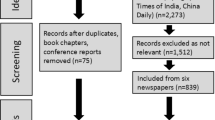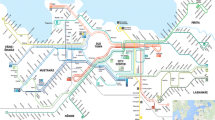Abstract
Assuming freight trip generation as the total number of freight vehicles arriving to retail establishments, for loading/unloading purposes and within a defined time period, we experiment and compare four alternative modeling methodologies to predict freight trip generation. The aim is to achieve better freight trip generation models, thus contributing to improving the chances of correctly dimension, for example, the parking infrastructure required to accommodate demand, or estimating the freight traffic impacts at micro level. Representing the state of the practice, the first two methodologies are based on cross-classification/category analysis. The third methodology uses a generalized linear model specification, a robust alternative to ordinary least squares linear regression. The fourth methodology consists in the exploration of a dependent variable simplification using an Ordinal Logit model. The main source of data is an Establishment-based Freight Survey, which collected data from 604 retail establishments in the city of Lisbon, Portugal. The selected independent variables were the establishments’ industry category, number of employees and retail area. The analysis allowed for the conclusion that (a) variable contribution varies depending on the chosen modelling methodology, (b) there is little variability in the quality of predictions depending on the selected model, but a considerable improvement in correct predictions can be achieved by reducing the variability of the dependent variable, and (c) the proposed indicator framework is suitable to compare model predictions and might be adequately represented by subset of those applied.




Similar content being viewed by others
References
Agresti, A.: An Introduction to Categorical Data Analysis, 2nd edn. Wiley, New York (2007)
Alho, A., de Abreu e Silva, J.: Freight trip generation model: predicting urban freight weekly parking demand from retail establishment characteristics. Transp. Res. Rec. 2411(2), 45–54 (2014)
Alho, A., de Abreu e Silva, J.: Modeling commercial establishments’ freight demand: a two-step approach to predict weekly deliveries in total of vehicles. In: Proceedings of the Transportation Research Board (TRB) 94th Annual Meeting 2015 (2015a)
Alho, A., de Abreu e Silva, J.: Lisbon’s Establishment-based Freight Survey: revealing retail establishments’ characteristics, goods ordering and delivery processes. Eur. Transp. Res. Rev. (2015b). doi:10.1007/s12544-015-0163-7
Alho, A., Lee, Y. J., Blanco, E., Zegras, C., de Abreu e Silva, J.: Freight Trip Generation in urban contexts: a comparison between Lisbon (PT) and Singapore (SG). In: CUPUM 2015—14th International Conference on Computers in Urban Planning and Urban Management, July 7–10, 2015, Cambridge, MA, USA (2015)
Alho, A., de Abreu e Silva, J., Pinho de Sousa, J., Blanco, E.: Decreasing congestion by optimizing the number, location and usage of loading/unloading bays for urban freight. In: Proceedings of the Transportation Research Board (TRB) 95th Annual Meeting (2016)
Anand, N., Van Duin, R., Quak, H., Tavasszy, L.: Relevance of city logistics modelling efforts: a review. Transp. Rev. (2015). doi:10.1080/01441647.2015.1052112
Browne, M., Allen, J., Nemoto, T., Visser, J.: Light goods vehicles in urban areas. Procedia Soc. Behav. Sci. 2(3), 5911–5919 (2010)
Comi, A., Site, P. D., Filippi, F., Nuzzolo, A.: Urban freight transport demand modelling: a state of the art. Eur. Trans. Issue 51, Paper no. 7 (2012)
Comi, A., Donnelly, R., Russo, F.: Urban Freight Models in Modelling Freight Transport by Tavasszy, L. and G. De Jong. Elsevier, Amsterdam (2014)
de Dios Ortúzar, J., Willumsen, L.G.: Modelling Transport, 4th edn. Wiley, New York (2011)
Giuliano, G., O’Brien, T., Dablanc, L., Holliday, K.: NCFRP Report 23—Synthesis of Freight Research in Urban Transportation Planning. Transportation Research Board, Washington (2013)
Guevara, C.A., Thomas, A.: Multiple classification analysis in trip production models. Transp. Policy 14(6), 514–522 (2007)
Holguín-Veras J., Lawson C., Ban J., Tavasszy L., Levinson H.S., Powers, E.L.: NCHRP Report 739/NCFRP Report 19: Freight Trip Generation and Land Use. Transportation Research Board of the National Academies (2012)
Holguín-Veras, J., Jaller, M., Destro, L., Ban, X., Lawson, C., Levinson, H.S.: Freight generation, freight trip generation, and perils of using constant trip rates. Transp. Res. Rec., Number 2224 (2011)
Holguín-Veras, J., Jaller, M., Sanchez-Diaz, I., Campbell, S., Lawson, C. (2014) Freight generation and freight trip generation models. In: Tavasszy, L., de Jong, G. (2013) Modelling Freight Transport, 1st edn. Elsevier, Amsterdam (2014)
Holguín-Veras, J., Sanchez-Diaz, I., Lawson, C., Jaller, M., Campbell, S., Levinson, H.S., Shin, H.-S.: Transferability of freight trip generation models. Transp. Res. Rec. 2379, 1–8 (2013)
Ibeas, A., Moura, J.L., Nuzzolo, A., Comi, A.: Urban freight transport demand: transferability of survey results analysis and models. Procedia Soc. Behav. Sci. 54, 1068–1079 (2012)
Lawson, C., Holguín-Veras, J., Sánchez-Díaz, I., Jaller, M., Campbell, S., Powers, E.: Estimated generation of freight trips based on land use. Transp. Res. Rec. 2269, 65–72 (2012)
Manning, W.G., Mullahy, J.: Estimating log models: to transform or not to transform? J. Health Econ. 20(4), 461–494 (2001)
Muñuzuri, J., Cortés, P., Guadix, J., Onieva, L.: Modeling Peak-Hour Urban Freight Movements with Limited Data Availability. Comput. Ind. Eng. 59(1), 34–44 (2010)
Patier, D., Routhier, J.L.: How to Improve the Capture of Urban Goods Movement Data? Presented at 8th International Conference on Survey Methods in Transport, Annecy, France (2008)
Sanchez-Diaz, I., Holguín-Veras, J., Wang, C.: Assessing the role of land-use, network characteristics, and spatial effects on freight trip attraction. In: Transportation Research Board 92nd Annual Meeting, Washington, DC (2013)
SAS Institute Inc.: Specialized Models Partition Models. http://www.jmp.com/support/help/Partition_Models.shtml (2015a). Accessed 9 March 2015
SAS Institute Inc.: Specialized Models Partition Models Statistical Details. http://www.jmp.com/support/help/Statistical_Details_8.shtml#1277120 (2015b). Accessed 9 March 2015
SAS Institute Inc.: Specialized Models Partition Models Validation. http://www.jmp.com/support/help/Validation_2.shtml#1276752 (2015c). Accessed 9 March 2015
Schoemaker, J., Allen. J., Huschebek, M., Monigl, J.: Quantification of urban freight transport effects I. BESTUFS Consortium (2006)
UCLA: Statistical Consulting Group: Stata Web Books/Regression with Stata/Chapter 2—Regression Diagnostics. http://www.ats.ucla.edu/Stat/stata/webbooks/reg/chapter2/statareg2.htm (2012). Accessed 9 March 2015
United Nations: World Urbanization Prospects 2014 Revision. http://esa.un.org/unpd/wup/Highlights/WUP2014-Highlights.pdf (2014). Accessed 9 March 2015
Acknowledgments
This paper was written while the first author, André Alho, was a Ph.D. Candidate at Instituto Superior Técnico, Universidade de Lisboa, Portugal. The authors would like to thank the STRAIGHTSOL Project, co-funded by the European Commission under the Seventh Framework Cooperation Work Programme Sustainable Surface Transport, for providing funding the collection of data used in this study.
Author information
Authors and Affiliations
Corresponding author
Rights and permissions
About this article
Cite this article
Alho, A.R., de Abreu e Silva, J. Modeling retail establishments’ freight trip generation: a comparison of methodologies to predict total weekly deliveries. Transportation 44, 1195–1212 (2017). https://doi.org/10.1007/s11116-016-9700-z
Published:
Issue Date:
DOI: https://doi.org/10.1007/s11116-016-9700-z




